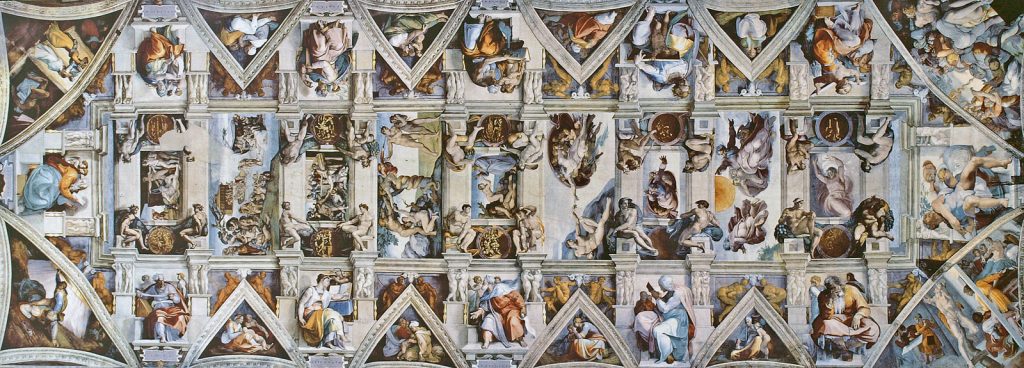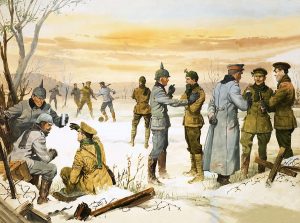From 1508 to 1512, it took Michelangelo five long, torturous years to complete the rigorous task of painting the ceiling of the Sistine Chapel. Spanning more than 10,000 square feet, the iconic piece of high Renaissance art is familiar to many people. Nevertheless, despite Michelangelo’s distinct ability to imply powerful expression and emotion into his art, most people fail to interpret the full story behind the talented artist’s five-year journey. Many may not realize that the beautiful, intricate depictions attributed to Michelangelo were actually painted by an unskilled artist. Likewise, one would not even dare think that the hand behind the brush had minimal interest in painting such marvelous masterpieces.
Michelangelo was by no means recognized as a skilled painter in his time. His fame, rather, came from the sculptures he chiseled in Rome and in Florence in his earlier years. His first sculpture in Rome was Bacchus (1496-1497), which he sculpted for a French ambassador’s barber. The French ambassador then commissioned Angelo to sculpt the Pietà (1498-1499). It was to be Michelangelo’s first contribution to the Catholic Church. The sculpture depicted the Virgin Mary holding the dead body of Jesus Christ. It was widely admired for the pure and simple expression of Mary and the holy serenity of Jesus even in the stillness of death. A few projects later, Angelo worked in Florence, sculpting the massive statue of the biblical hero David. The sculpture David (1501-1504) left Florentine citizens and artists, such as Leonardo Da Vinci, in awe. Eventually, he was assigned to work with Da Vinci painting war cartoons on the walls of the great municipal hall of Florence, known as the Palazzo Vecchio. After treating Da Vinci with severe discourtesy, he was summoned to Rome, by Pope Julius II for a new commission in 1505.1

Upon arriving in Rome, Michelangelo was employed to work on a mausoleum, or sepulcher, for the pope. Julius desired a tomb spanning eight hundred square feet, three stories high, and adorned with twenty six statues. He was willing to pay Michelangelo more than two hundred thousand crowns to complete the grand project. However, the pope’s desires were too extravagant and the expense was absurdly high, so the St. Peter’s basilica, where he desired his tomb to lay, would not allow it. Julius II and Angelo had developed an intimate friendship at this point, as they shared a proud, willful, and honest character. It was tough love between them; they always found a way to reconcile after constant quarreling and the loss of each others’ trust. Suddenly, however, after being denied his mausoleum, the pope’s demeanor changed and he excluded Angelo from the Vatican.2 Donato Bramante, a papal Italian architect, instigated this trouble by warning the pope of the evil omen he invited by constructing his death monument during his lifetime. Jealous of Angelo’s illustrious talent, Bramante encouraged Julius to hire Michelangelo to paint the ceiling of the Sistine Chapel instead, hoping that he would fail miserably. Meanwhile, triggered by his banishment, Michelangelo decided to abandon the pope and return to Florence.3
Three years later, in 1508, after multiple attempts by the pope to forcibly return the skilled artists to Rome, Michelangelo finally met with him. The pope hired him to paint frescoes of the twelve Apostles on the Sistine Chapel ceiling, but Angelo hesitated, knowing that he had inadequate practice with fresco-painting. Nonetheless, Julius repeatedly urged Angelo to accept the job, until finally, Angelo reluctantly gave consent under one condition.4 Michelangelo asked that something more tasteful be painted on the ceiling; he wanted to be allowed to “do as he pleases.” He suggested nine scenes from the book of Genesis, beginning with the creation of the world and ending with Noah and the flood.5

The pope granted his request, and Michelangelo started right away. Bramante was given the task of constructing the scaffolding, but his approach was inefficient and it made holes in the ceiling. This angered Angelo so much that he got the pope’s permission to banish Bramante, and he make the scaffold himself. After making a better scaffold structure, Michelangelo still doubted his abilities for the task, so he summoned his childhood friend, Francesco Granacci, to aid him in preparing designs for the frescoes. Angelo got the hang of it quickly, and soon enough, Granacci and two other assistants were painting over the master’s chalk outlines. Michelangelo’s arrogance engulfed him though, and he regretted inviting his three assistants, who could not express the art in harmony with his detailed ideas. He sent his friends back to Florence and set forth on the project alone, where he spent most of his days alone in the sombre space between the platform and the ceiling. Michelangelo became frustrated; he ached daily from having his head thrown back, spine arched downward, and face covered in paint. Matters only got worse as the winter neared.6
From May until the first winter, nearly one third of the ceiling was complete, but it was all ruined by mold that developed under the perfect conditions of the cold weather and moisture in the Roman lime Michelangelo used to make the plaster. Devastated, Angelo gave up, and shouted to the pope, “I told you I was no fresco-painter; what I have done is ruined.” He took a break from the project for nearly a year, as he waited for favorable weather and for the mold to disappear. It was after this break that Michelangelo’s frescoes underwent an evident change. The paintings became larger and more expressive and emotional. He continued the back-breaking work until it was finally completed in 1512.7
Notably, one well-known fresco that depicts The Creating of Adam, clearly demonstrates Michelangelo’s shift in form and style. The large twisted bodies are very expressive, and the movements portray a strong emotion that can be easily perceived, even from the chapel ground! This style completely contrasts Angelo’s first few frescoes, which were small and complicated. In particular, the scene of The Great Flood is full of action when viewed up close. The fresco contains four stories alone, but they cannot be seen well from the ground. Michelangelo was aware of this issue, but he decided not to feed his frustration and continued painting the ceiling, with the new approach.

Completing the job was not easy for Michelangelo, he had to fight through the strong hatred he developed while painfully painting the frescoes. Some scholars believe that Michelangelo suffered from deconditioning syndrome, which is a state of physical and emotional lethargy as a result of a lack of exercise or movement for long periods of time.8 However, this is due to a common misconception that he worked laying down on the scaffolds, close to the ceiling. In fact, Michelangelo spent hours upon hours with his head bent back, his spine curling in on itself, and his feet aching because he painted standing upright on his designed scaffold. He regretted ever accepting the task; he even wrote a poem in 1509 describing how much he loathed the whole situation:
From the year 1513, when the chapel finally reopened to the public, until the present day, Michelangelo’s arduous accomplishment lives on as a renowned piece of art. The paintings have acquired a low tone due to withering and reckless care, but they still stand to show that he conquered the task and surpassed those who doubted him. Although it may have costed him physical and mental health, his dedication and skill continue to inspire artists and historians, and astonish all those who view his works.10

- Moses Sweetser, Michael Angelo (Michigan: Houghton, Osgood and company, 1878), 23-35. ↵
- Moses Sweetser, Michael Angelo (Michigan: Houghton, Osgood and company, 1878), 34. ↵
- “Michelangelo’s Painting of the Sistine Chapel Ceiling,” ItalianRenaissance.org, May 9, 2013, http://www.italianrenaisance.org. ↵
- Moses Sweetser, Michael Angelo (Michigan: Houghton, Osgood and company, 1878), 48-49. ↵
- “Michelangelo’s Painting of the Sistine Chapel Ceiling,” ItalianRenaissance.org, May 9, 2013, http://www.italianrenaissance.org ↵
- Moses Sweetser, Michael Angelo (Michigan: Houghton, Osgood and company, 1878), 50. ↵
- Andrew Graham-Dixon, Michelangelo and the Sistine Chapel (New York: Skyhouse Pub, 2009), 1-35. ↵
- Raffaella Bianucci et al., “Michelangelo Buonarroti (1475-1564) had the Deconditioning Syndrome While painting the Sistine Chapel Ceiling,” Medical Hypotheses 113, (April 2018): 13-14. ↵
- Gail Mazur, “Michelangelo: To Giovanni Da Pistoia When the Author Was Painting the Vault of the Sistine Chapel,” Poetry 1, no. 1 (2005): https://www.poetryfoundation.org/poems/57328. ↵
- Moses Sweetser, Michael Angelo (Michigan: Houghton, Osgood and company, 1878), 57-58. ↵



120 comments
Maria Martinez
This is an amazing article! I had heard of the paintings in the Sistine Chapel before but I never knew of the story of how they came to be. The fact that Michelangelo struggled so much with the task was mind blowing because as someone who is not very knowledgeable with art history I always assumed his talent came to him effortlessly. It is also so cool that one can see how his style of painting improved from one area of the ceiling to the rest after his break.
Mariah Garcia
This article was so interesting! It is always a pleasure to read about the creations and thought process of one of the greatest artists in history, and his art is always to be admired. I really enjoyed the attention to little details and definitely felt as though I had learned something after reading this article. It was an easy read.
Sarah Uhlig
I loved the artwork that this man created. His pieces of work are very well known but it is sad to read that he wasn’t at first acknowledged for his work. It was good to read about how the Pope gave him the job to paint the Sistine Chapel. It is very well known for the beauty of the work that he had done and his paintings in certain spots are vary famous and can be found in parts of the Catholic faith in which we study.
Ruben Basaldu
I thought that this was a fun and interesting read. I find it so crazy that Michelangelo took five years to finish this painting. I have never been able to see this painting in person but I am sure that it is truly a sight to see and is something that I do want to see one day. I never knew all about the things that he was going through while he was painting this. While he might not have wanted to take this task a lot of people have seen this painting and appreciate that he did do it.
Katherine Wolf
I have had the privilege of seeing the Sistine Chapel in person and I can attest that no picture can do justice to the beauty of Michelangelo’s work. It is amazing how you can see form and expression in the figures on the ceiling all the way down at the floor. It is very sad to learn that such a magnificent piece of work brought its creator such anguish. Michelangelo seemed to be temperamental even before he started work on the chapel and the stress probably brought out the worst of it.
Brianna Nevarez
To be so skilled at something that you hate, to think you are not talented in an area and end up creating something as beautifully as Michael Angelo did, that is a still. The fact that Michael Angelo was a sculptor not a painter and still managed to create this beautiful paintings, it is worthy of an award. I read an article where Michael Angelo worked so arduously while making the frescoes, his shoes got stuck to his feet. The combination of water, moisture and dirt made the shoes stick to his skin since he would not remove them so he could continue working.
Alicia Guzman
I think one of the most beautiful things that I have ever seen in mI think one of the most beautiful things that I have ever seen in my life has been the Sistine Chapel in Vatican City. Michelangelo was truly masterful even though his best trade was sculpting. Though this article talks about a topic that is often not known, he had to muster up so much energy and will to complete this task. He was forced by the Pope to come back and complete the task, molded out at one point, and sick with frustration for a majority of the time. While it is sad that he regretted accepting the job, millions are thankful he did.
Averie Mendez
This article was very interesting to read. I wasn’t aware of how many hardships and obstacles were in Michelangelo’s path as he worked on painting the Sistine Chapel. The amount of excruciating pain endless hours of tilting his head up paid off though, as he painted one of the most beautiful, intricate and recognized art pieces in all of history.
Noah Wesolowski
I have always seen pictures of the paintings in the Sistine Chapel but I have never know the story of how they were created. It’s interesting how many issues Michelangelo had while he was working on the paintings. As he was set up for failure by Donato Bramante who not expected him to fail also tried to sabotage his work by putting holes in the ceiling.
Alexandra Lopez
Congratulations on your nomination. This article was a great read. Fascinating story the author tells of Michelangelo and how he took five years to paint the Sistine Chapel. I did not realize what physical turmoil it took on Michelangelo’s health to paint this masterpiece. I enjoyed reading this article, it was interesting and uplifting. (reposted)